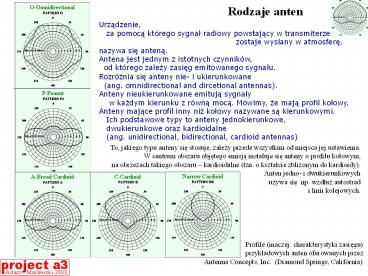Rodzaje anten - PowerPoint PPT Presentation
Title:
Rodzaje anten
Description:
Antena kardioidalna 1 Author: amarlew Last modified by: amarlew Created Date: 2/19/2003 1:34:25 PM Document presentation format: Pokaz na ekranie Company: – PowerPoint PPT presentation
Number of Views:46
Avg rating:3.0/5.0
Title: Rodzaje anten
1
Rodzaje anten
Urzadzenie, za pomoca którego sygnal radiowy
powstajacy w transmiterze
zostaje wyslany w
atmosfere, nazywa sie antena. Antena jest
jednym z istotnych czynników, od którego
zalezy zasieg emitowanego sygnalu.
Rozróznia sie anteny nie- i ukierunkowane
(ang. omnidirectional and dircetional
antennas). Anteny nieukierunkowane emituja
sygnaly w kazdym kierunku z równa moca.
Mówimy, ze maja profil kolowy. Anteny majace
profil inny niz kolowy nazywane sa kierunkowymi.
Ich podstawowe typy to anteny
jednokierunkowe, dwukierunkowe oraz
kardioidalne (ang. unidirectional,
bidirectional, cardioid antennas)
To, jakiego typu anteny sie stosuje, zalezy
przede wszystkim od miejsca jej ustawienia. W
centrum obszaru objetego emisja instaluje sie
anteny o profilu kolowym, na obrzezach takiego
obszaru kardioidalne (tzn. o ksztalcie
zblizonym do kardioidy).
Anten jedno- i dwukierunkowych
uzywa sie np. wzdluz
autostrad
i linii kolejowych.
Profile
(inaczej charakterystyki zasiegu)
przykladowych anten
oferowanych przez Antenna Concepts,
Inc. (Diamond Springs, California)
2
Nadziemne anteny kardioidalne
The cardioid antenna produces a heart-shaped
radiation pattern that is more
concentrated in one direction, allowing a longer
maximum range. Cardioid antennas are used
when the antenna will be located near the edge of
the coverage area. This concentration of energy
in one direction reduces the coverage in the
opposite direction. This tends to reject radio
signals being received from that direction. Thus
reducing the amount of interference and unwanted
signals.
ze strony http//tx.mb21.co.uk/gallery/larkstoke.
asp (12.III.2003)
Lark
Stoke (south of Stratford-upon-Avon) Th
e broadcast mast is only 13.5m high with
a UHF (ultra high frequency)
cardioid antenna
poking out the top radiating the 4 analogue
services and Mux BBC, D3/4, SDN (Streamline
Digital Network) and Mux B (multiplexer).
The VHF (very high frequency) antenna is below
that and the DDT (delayed diversity
transmission) antenna for Mux CD
is further below at around 8.5m from the
ground.
3
Anteny kardioidalne w bezzalogowych pojazdach
powietrznych
Zaprezentowane w artykule A simple control law
for UAV formation flying (autorzy E.W.Justh,
P.S.Krishnaprasad TR 2002-38, Institute for
System Research, University of Maryland)
charakterystyki uzycia par anten kardioidalnych
wychwytujacych sygnaly (a) jedna para -
sygnal pojedynczy (b) jedna para - dwa sygnaly
o róznych czestotliwosciach (d) dwie pary
anten - tony o czterech róznych
czestotliwosciach. Ponadto (c) wykres róznicy
mocy sygnalu odbieranego w zaleznosci od kata -
mierzonego w radianach - miedzy transmitujacymi
UAV (unmanned aerial vehicles) a linia bazowa
nadajnika.
Anteny kardioidalne w UAV
4
Mikrofony kardioidalne
http//www.cadmics.com/ The CAD 22A is a dynamic
cardioid microphone designed with the
qualities required by the professional, but
priced for the budget conscious vocalist and
musician. It features a frequency response
covering the audible range necessary for accurate
natural sound, and a uniform cardioid polar
pattern that reduces annoying feedback
when used in close proximity
to sound reinforcement
speakers and monitors. A warm bass-boost
(proximity effect) is achievable by working close
to the CAD 22A. Also, the built-in presence
boost provides the additional punch
needed in sound reinforcement. The CAD 22A is
supplied complete with a swivel mount, on/off
switch with recessed button, an effective
internal multi-stage blast filter to minimize
wind and breath noise, and an effective
rubber shock mount to reduce cable, stand and
handling noise.
Przykladowa informacja producencka dot. mikrofonu
kardioidalnego
Przykladowa reklama mikrofonów kardioidalnych

